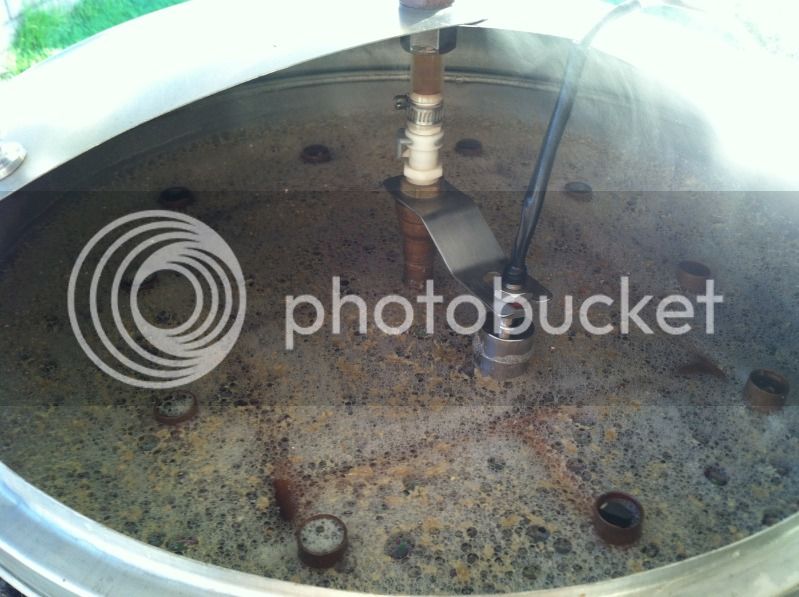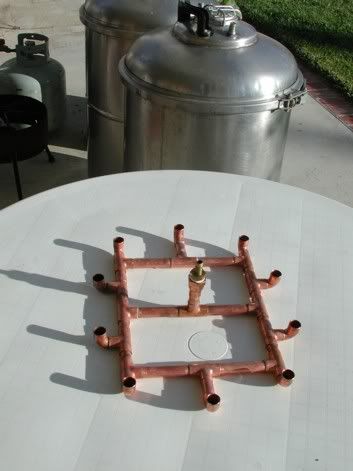You are using an out of date browser. It may not display this or other websites correctly.
You should upgrade or use an alternative browser.
You should upgrade or use an alternative browser.
Hot side oxidation and HERMS
- Thread starter Knew2Brew
- Start date

Help Support Homebrew Talk - Beer, Wine, Mead, & Cider Brewing Discussion Forum:
This site may earn a commission from merchant affiliate
links, including eBay, Amazon, and others.
many believe HSA is a myth. Now even if you believe in it, your herms loop is all closed. Just so long as you are gently getting the wort back on tap of the grain bed there is nothing to worry about.
many believe HSA is a myth. Now even if you believe in it, your herms loop is all closed. Just so long as you are gently getting the wort back on tap of the grain bed there is nothing to worry about.
Whether hot side oxidation is real or not is another issue, but spraying fine droplets or even a mist of wort in atmosphere that is 21% oxygen is the best way toput oxygen into your wort. It's like a vacuum degas system in reverse.
Just keep in mind that it is easier to add gasses to cold liquid than it is warm or hot liquid.
If I recall correctly, HSA is a concern when temps are above 170. Since mashing doesn't reach this level, we don't have to worry.
I don't worry about HSA anyway.
Palmer says 80 in How to Brew.
Just keep in mind that it is easier to add gasses to cold liquid than it is warm or hot liquid.
True, the hotter the liquid the less dissolved gas it will hold. It's my understading in hot wort that oxygen in wort combines with other stuff to make compounds that give the oxidized flavor that some report. I'm a novice with few batches under my belt so I haven't experienced these problems, but would someday like a nice herms system and don't want to build something that makes bad beer. Once the oxygen has combined with something else, the oxygen concentration goes down in the wort. The wort will absorb more oxygen to come to equilibrium. More oxygen makes more compounds, wash, rinse, and repeat. They cycle continues itself as one recircs their wort all the while making compounds in their wort to cause oxidized flavors.
- Joined
- Jul 30, 2008
- Messages
- 660
- Reaction score
- 48
I don't run a HERMS, so please pardon my ignorance, but why spray droplets of wort to expose it to air and to the chance for oxidation, or for that matter for evaporative cooling? Why not drop your recirculation return to the level of the top of your mash?
I'm quite stale on my chemistry, but IIRC boiling means that you have reached the temperature where the solvent goes from liquid to gas somewhat vigorously. Does it really purge gases? Isn't their concentration simply lessened as the temperature rises? I do believe Knew2Brew has a good point. Boiling does not get rid of solutes, including oxidized carbohydrates, so stale is still very much an option.
I'm quite stale on my chemistry, but IIRC boiling means that you have reached the temperature where the solvent goes from liquid to gas somewhat vigorously. Does it really purge gases? Isn't their concentration simply lessened as the temperature rises? I do believe Knew2Brew has a good point. Boiling does not get rid of solutes, including oxidized carbohydrates, so stale is still very much an option.
I don't think I've ever seen a HERMS system that uses a fly sparge style return.
Most use some form of a return that places the liquor above the grain bed, but below the liquor level. You're vorlaufing, not sparging.
Boiling purges all dissolved gases.
You can believe me or not, been doing it for years and narry an oxidized batch.
Most use some form of a return that places the liquor above the grain bed, but below the liquor level. You're vorlaufing, not sparging.
Boiling purges all dissolved gases.
You can believe me or not, been doing it for years and narry an oxidized batch.
Monster Mash
Well-Known Member
I believe in HSA because I had a problem with it for a while. For those that brew 5 - 10 gallons it's not an issue because the beer does not sit long, when you have kegs sitting for 6 months it becomes an issue. I do believe that pre-boil HSA is not much of an issue because you will boil it off anyways but it's still a good idea to keep the splashing down to a minimum.
My HERMS return is in the liquid above the mash so there is no spraying the wort.
My HERMS return is in the liquid above the mash so there is no spraying the wort.
So how do you people with your HERMS systems set up your return so that it is below the liquid, but above the grain for different batches? Some batches have more grain and water than others while mashing so is there some type of adjustable return on the sparge line?
i use loc line from brewhardware. http://www.brewhardware.com/accessories/114-mashtube
Monster Mash
Well-Known Member
So how do you people with your HERMS systems set up your return so that it is below the liquid, but above the grain for different batches? Some batches have more grain and water than others while mashing so is there some type of adjustable return on the sparge line?
I have a copper manifold that sits on top of the grain bed.


kal
Well-Known Member
+1 to that. It's what I do as well and it works very effectively. It's what Sabco does in their BrewMagic setups that they've sold for years (and sold thousands). It's also what Blichmann does with their auto-sparge arm.I use 3-4' of silicon tubing on the return. Just lay it on the grain bed and walk away.
IMHO sometimes simpler is better.
Kal
IMHO sometimes simpler is better.
Kal
+1 There's already too much to overthink already. No reason to make your process/equipment an additional one as well.
Jelliz
Active Member
Maybe I'm under thinking here but, if you are introducing oxygen during the mash through recirculating isn't it going to be mostly eliminated though the boil anyway. I thought hot side aeration would be a concern after the boil if splashing occurs before the wort is cooled.
Maybe I'm under thinking here but, if you are introducing oxygen during the mash through recirculating isn't it going to be mostly eliminated though the boil anyway. I thought hot side aeration would be a concern after the boil if splashing occurs before the wort is cooled.
i agree with you on this.
tophmck
Well-Known Member
- Joined
- Oct 2, 2009
- Messages
- 191
- Reaction score
- 4
Maybe I'm under thinking here but, if you are introducing oxygen during the mash through recirculating isn't it going to be mostly eliminated though the boil anyway. I thought hot side aeration would be a concern after the boil if splashing occurs before the wort is cooled.
The conventional wisdom on hot side aeration (HSA) was that it could arise before, after, and possibly even during the boil. This page has some discussion of why. But it doesn't really matter, though, since the more modern view is that HSA isn't an issue on the home brewing scale. (The best evidence of this is the experiment on Basic Brewing Radio in which some brewers tried as hard as they could to aerate their wort on the hot side and ended up with no discernible off-flavors.)
Has anyone ever had a close-up view of a commercial scale brewery in action? I had the opportunity to brew on a 15 barrel system and during the mash they recirculate, and as the wort recirculates it is literally sprayed out, it's not a gentle stream, it's a spray with pretty fine droplets. Kinda like what you see coming from a fire sprinkler. If HSA were a problem I don't think they would vorlauf in this manner.
kal
Well-Known Member
Are you sure it was wort coming out and not water during sparging?Has anyone ever had a close-up view of a commercial scale brewery in action? I had the opportunity to brew on a 15 barrel system and during the mash they recirculate, and as the wort recirculates it is literally sprayed out, it's not a gentle stream, it's a spray with pretty fine droplets. Kinda like what you see coming from a fire sprinkler.
Kal
Are you sure it was wort coming out and not water during sparging?
Kal
I'm pretty certain that after we doughed in we let it sit for about 30 mins, then turned on the pumps to recirculate the wort for about 30 minutes for vorlauf, then moved opened and closed some valves to stop the recirculation and start the lauter i.e. sparge
wailingguitar
Well-Known Member
Has anyone ever had a close-up view of a commercial scale brewery in action? I had the opportunity to brew on a 15 barrel system and during the mash they recirculate, and as the wort recirculates it is literally sprayed out, it's not a gentle stream, it's a spray with pretty fine droplets. Kinda like what you see coming from a fire sprinkler. If HSA were a problem I don't think they would vorlauf in this manner.
I have brewed on around a dozen commercial systems, from 1-50bbls and never saw wort "sprayed" out on recirc. I don't think it is necessarily a bad thing, just never saw it that way. Usually there is a return that directs the flow to the mash tun wall where it fans out and runs down the side back to the grain bed.
Now, something that DOES spray the wort is a kettle calandria. For those not familiar, the calandria sits in the middle of the kettle and is the primary heat source. Wort is pumped in the bottom, heated by steam as it rises then sprays out in a 360 degree pattern back into the kettle. Many companies use them, they used to be seen only on large kettles, say 50bbl+, but they are showing up on smaller systems.
Here is a short vid showing a calandria in action:
Last edited by a moderator:
Similar threads
- Replies
- 18
- Views
- 940
- Replies
- 4
- Views
- 555
- Replies
- 17
- Views
- 1K
- Replies
- 12
- Views
- 2K

